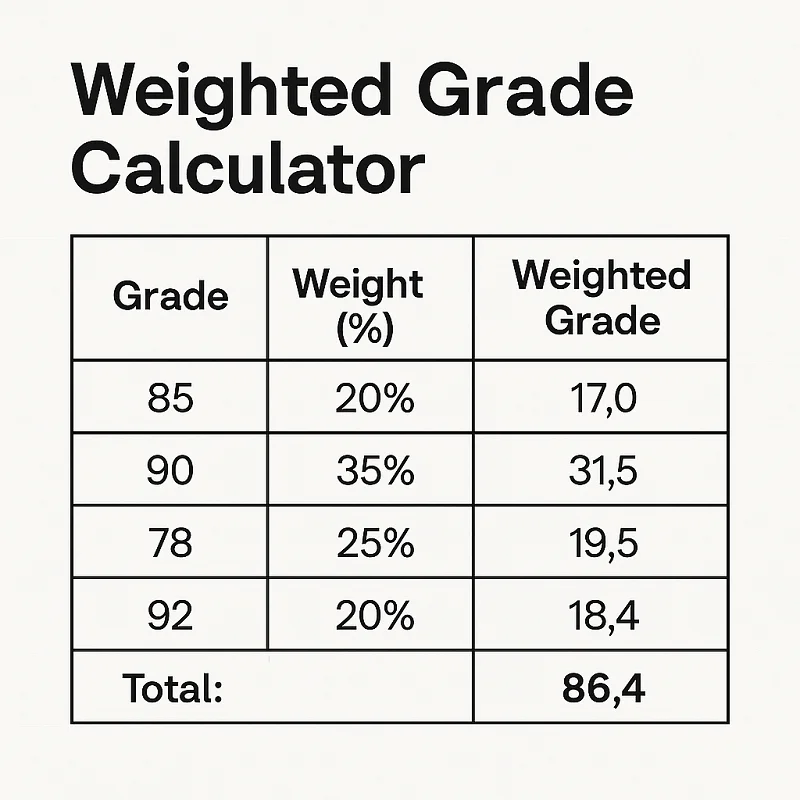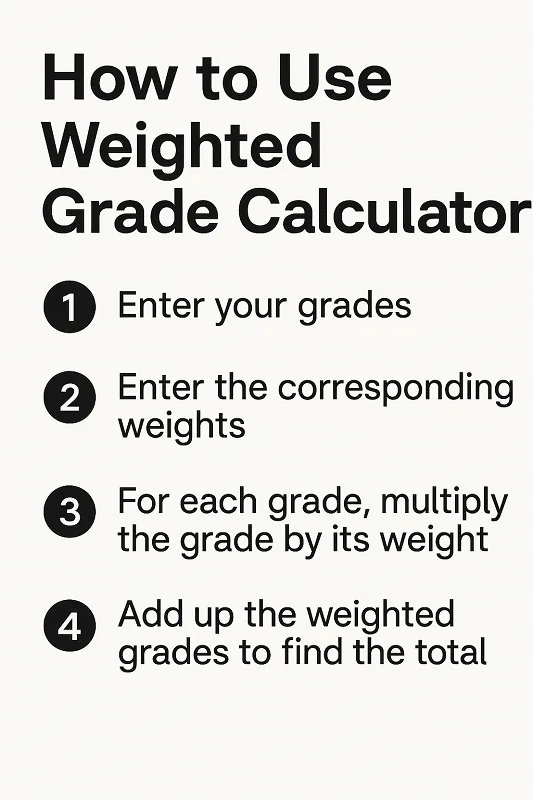📚 Assignments
| Assignment Name | Grade (%) | Weight (%) | Action |
|---|---|---|---|
Calculate your final grade based on weighted assignments
| Assignment Name | Grade (%) | Weight (%) | Action |
|---|---|---|---|
Getting accurate grades is crucial for academic success, but calculating weighted averages can be confusing. A weighted grade calculator simplifies this process by automatically computing your final grade based on different assignment categories and their respective weights. Whether you’re a student tracking your progress or planning what grade you need on your final exam, this tool eliminates the guesswork and provides instant, accurate results.
A weighted grade calculator is a digital tool that computes your final course grade by considering both your individual assignment scores and the relative importance (weight) of each assignment category. Unlike a simple average that treats all assignments equally, weighted grades reflect the actual grading structure of your course.
Weighted vs. Simple Average:
For example, if your midterm is worth 30% and homework is worth 20%, the midterm carries more influence on your final grade than individual homework assignments. This weighted approach provides a more accurate representation of your academic performance according to your instructor’s grading policy.
Follow these simple steps to calculate your weighted grade accurately:
Input your earned grades for each assignment category. You can enter grades as:
Make sure to use consistent formatting within each category. If you haven’t completed an assignment yet, leave that field blank or enter “0” if it significantly impacts your calculation.
Enter the weight percentage for each assignment category as specified in your course syllabus. Common weight distributions include:
Important: All weights must add up to 100% for accurate results.
Once you’ve entered all grades and weights, click the “Calculate” button. The calculator will instantly display:
Most weighted grade calculators allow you to:

The weighted grade formula is straightforward once you understand the components:
Weighted Grade = (Grade₁ × Weight₁) + (Grade₂ × Weight₂) + … + (Gradeₙ × Weightₙ)
Where:
Step-by-step breakdown:
Example calculation:
Biology 101 Grading Structure:
Calculation:
English Literature Class:
Calculation:
Sometimes you need to work backwards to determine what grade you need on your final exam to achieve a target course grade. This reverse calculation is particularly useful for academic planning and goal setting.
Formula for required final exam grade: Required Grade = (Target Grade – Current Weighted Score) ÷ Final Exam Weight
Example scenario:
Calculation:
You would need to score at least 89.5% on your final exam to achieve an 85% in the course.
Weighted grades provide several key advantages for both students and educators:
Academic Accuracy: They reflect the true importance of different assignment types, ensuring that major exams carry more weight than daily quizzes.
Motivation and Planning: Students can prioritize their study efforts on high-weight assignments and understand exactly how each grade impacts their overall performance.
GPA Calculation: Many schools use weighted grades for GPA calculations, making them crucial for academic standing, scholarships, and college admissions.
Real-World Preparation: Weighted systems mirror workplace evaluation methods where different responsibilities carry varying levels of importance.
Weights Not Adding Up to 100%: Always verify that your assignment weights total exactly 100%. If they don’t, your calculation will be inaccurate.
Mixing Grade Formats: Don’t combine percentages (85%) with letter grades (B+) unless you’re using a calculator that properly converts between formats.
Including Incomplete Assignments: If you haven’t completed an assignment, either exclude it from the calculation or clearly note that it’s a projected grade.
Forgetting Extra Credit: Some courses include extra credit opportunities that can boost your weighted average beyond the standard scale.
Using Wrong Decimal Places: Be precise with your calculations, especially when grades are close to letter grade boundaries.
Understanding the difference between weighted and unweighted grades is crucial for academic planning:
Unweighted Grades:
Weighted Grades:
GPA Impact:

Yes, weighted grade calculators work for any course that uses a weighted grading system, regardless of subject matter.
If no weights are specified, assume equal weighting for all assignments or ask your instructor for clarification.
Add extra credit points to the appropriate category before calculating the weighted average, or calculate it separately and add to your final grade.
While weighted grade calculators help determine individual course grades, GPA calculation requires additional steps involving credit hours and quality points.
You can either exclude incomplete assignments from the calculation or estimate their impact using projected grades.
Yes, many graduate programs use weighted grading systems, making these calculators equally valuable for advanced coursework.
Enhance your academic planning with these complementary calculation tools:
GPA Calculator: Convert your course grades into cumulative or semester GPA using credit hours and quality points.
Final Grade Calculator: Determine what grade you need on your final exam to achieve a specific course grade.
Simple Average Calculator: Calculate unweighted averages for courses that don’t use weighted grading systems.
Grade Tracker Template: Organize and monitor your assignments, due dates, and grades throughout the semester.
Percentage to Letter Grade Converter: Convert numerical grades to letter grades using standard or custom grading scales.
Course Grade Calculator: Plan your semester by projecting grades across multiple courses and credit hours.
Take control of your academic success by using our weighted grade calculator today. Whether you’re tracking your current progress, planning your study schedule, or determining what grade you need on upcoming assignments, this tool provides the accuracy and convenience you need.
Simply enter your grades and weights, click calculate, and instantly see your weighted average. Use this information to make informed decisions about your study priorities and academic goals. Remember to recalculate as you complete new assignments to maintain an accurate picture of your course performance.
Start calculating your weighted grades now and transform the way you approach your coursework. Your future self will thank you for the clarity and confidence that comes with knowing exactly where you stand academically.